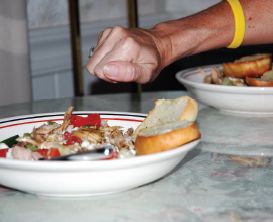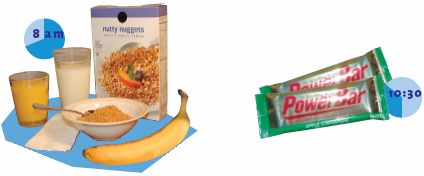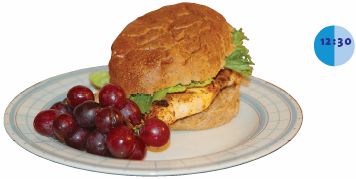
Gaining control over your calorie intake is crucial for body fat reduction. Runners often complain that even though they have increased mileage, and faithfully done their cross-training workouts, they are not losing weight. In every case, when I have questioned them, each did not have a handle on the amount of calories they were eating. In every case, when they went through the drill of quantifying, each was eating more than they thought. Below you will find ways to take 10 or more pounds off your body—without starving yourself.
Websites tell you calorie balance and nutrient balance
The best tool I’ve found for managing your food intake is a good website or software program. There are a number of these that will help to balance your calorie bottom line (calories burned vs calories eaten). Most of these will have you log in your exercise for the day, and what you eat. At the end of the day, you can retrieve an accounting of calories, and of nutrients. If you are low on certain vitamins or minerals, protein, etc, after dinner, you can eat food or a vitamin pill. Some programs will tell vegetarians whether they have received enough complete protein, since this nutrient is harder to put together from vegetable sources. If you haven’t received enough of some nutrient, you can do something about it that night, or the next morning to make up the deficit. If you ate too many calories, walk after dinner or boost tomorrow’s workouts, or reduce the calories, or both. For information on current websites visit www.JeffGalloway.com. It helps to try several before choosing one.
I don’t recommend letting any website control your nutritional life until the end of your days. At first, it helps to use it every day for 1-2 weeks. During this time, you’ll see patterns, and note where you tend to need supplementation or should cut back. Every week or two, do a spot check during 2-3 days. Some folks need more spot checks than others. If you’re more motivated to eat the right foods and quantities by logging in every day, go for it.
Portion control—through logging your food intake
Whether you use a website or not, a very productive drill is that of logging what you eat every day, for a week. Bring a little note pad, and a small scale if you need it. As people log in, and then analyze the calories in each portion, they are almost always surprised at the number of calories they are eating. The fat content is often another surprise. Many foods have the fat so well disguised that you don’t realize how much you are eating.

A portion of most foods is about the size of a fist
After doing this drill for several days you start to adjust the amount that you eat each meal. You are becoming the captain of your nutritional ship! Many runners have told me that they resented the first week of logging in, but it became fairly routine after that. Once you get used to doing this, you become aware of what you will be putting in your mouth, and are more likely to gradually change your eating behaviors.
Eating every 2 hours
As mentioned in the previous chapter, if you have not eaten for about 3 hours your body senses that it is going into a starvation mode, reducing the metabolism rate while increasing the production of fat-depositing enzymes. This means that you will not be burning as many calories as is normal, that you won’t be as mentally and physically alert, and that more of your next meal will be stored away as fat. If the starvation reflex starts working after 3 hours, then you can beat it by eating every 2 hours. This is a great way to burn more calories. A person who now eats 2-3 times a day, can burn about 8-10 pounds a year more when he or she shifts to eating 8-10 times a day. This assumes that the same calories are eaten every day, in the same foods.


Big meals slow you down
Big meals are a big production for the digestive system. Blood is diverted to the long and winding intestine and the stomach. Because of the workload, the body tends to shut down blood flow to other areas, leaving you feeling more lethargic and sedentary. Exercising muscles will be deprived of oxygen after a big meal as the blood surrounds the gut during digestion.
Small meals speed you up
Smaller amounts of food can usually be processed quickly without putting a burden on the digestive system. Each time you eat a small meal or snack, your metabolism speeds up. Revving up the metabolism, several times a day means “more calories burned”.
You also give a setback to your set point
When you wait more than three hours between meals the set point engages the starvation reflex. But if you eat every 2-3 hours, the set point is not engaged—due to the regular supply of food. Therefore the fat depositing enzymes don’t have to be stimulated.
Motivation increases when you eat more often
The most common reason I’ve found for low motivation in the afternoon is not eating regularly enough during the day—especially during the afternoon. If you have not eaten for 4 hours or more, and you’re scheduled for a run that afternoon, you will not feel very motivated—because of low blood sugar and low metabolism. Even when you have had a bad eating day, and feel down in the dumps, you can gear up for a run-walk by having a snack 30-60 minutes before exercise. A fibrous energy bar with a cup of coffee (tea, diet drink) can reverse the negative mindset. But you don’t have to get yourself into this situation if you eat every 2-3 hours.
Satisfaction from a small meal to avoid overeating
The number of calories you eat per day can be reduced by choosing foods and combinations of foods that leave you satisfied longer. Sugar is the worst problem in calorie control and satisfaction. When you drink a beverage with sugar in it, the sugar will be processed very quickly, and you will often be hungry within 30 minutes—even after consuming a high quantity of calories. This will usually lead to two undesirable outcomes:
| 1. | Eating more food to satisfy hunger. |
| 2. | Being hungry and triggering the starvation reflex. |
Your mission is to find the right combination of foods in your small meals that will leave you satisfied for 2-3 hours. Then eat another snack that will do the same. You will find a growing number of food combinations that probably have fewer calories, but keep you from getting hungry until your next snack.
Nutrients that leave you satisfied longer
Fat
Fat will leave you satisfied from a small meal because it slows down digestion, but a little goes a long way. When the fat content of a meal goes beyond 30%, you start to feel more lethargic due to the fact that fat is harder to digest. While a meal composed of up to about 18% of the calories in fat will help you hold hunger at bay, meals with a higher percentage of fat can compromise a fat-burning program. Fat is automatically deposited on your body. None of the dietary fat is used for energy. When you eat a fatty meal, you might as well inject it onto your hips or stomach. The fat you burn as fuel must be broken down from the stored fat on your body. The bottom line: a little fat with a snack can keep you satisfied longer, but a lot of it will mean more fat on your body.
There are two kinds of fat that have been found to cause narrowing of the arteries around the heart and leading to your brain: saturated fat and trans fat. Mono and unsaturated fats, from vegetable sources, are usually healthy—olive oil, nuts, avocado, safflower oil. Some fish oils have Omega 3 fatty acids which have been shown to have a protective effect on the heart. Many fish have oil that is not protective.
Look carefully at the labels because a lot of foods have vegetable oils that have been processed into trans fat. A wide range of baked goods and other foods have trans fat. It helps to check the labels and call the 800 number on the package to find out fat composition. The simplest solution is to avoid the food.
Protein—lean protein is best
This nutrient is needed every day for rebuilding the muscle that we break down during daily exercise and normal wear and tear. Runners, even those who log high mileage, don’t need to eat significantly more protein than sedentary people. But if runners don’t get their usual amount of protein, they feel more aches and pains, and general weakness, sooner than average people.
Having protein with each meal will make you feel satisfied for a longer period of time. But eating more protein calories than you need will produce a conversion of the excess into fat.
Recently, protein has been added to sports drinks with great success. When a drink with 80% carbohydrate and 20% protein (such as Accelerade) is consumed within 30 minutes of the start of a run, glycogen is activated better, and energy is supplied sooner and better. By consuming a drink that has the same ratio (like Endurox R4) within 30 minutes of finishing a run, the reloading of the muscles has been shown to be more complete.
Complex carbohydrates give you a “discount” and a “grace period”
The fiber in foods such as celery, beans, cabbage, spinach, turnip greens, grape nuts, whole grain cereal, etc, can force the digestive system to burn up to 25 % of the calories in digestion. As opposed to fat (which is directly deposited on your body after eating it) it is only the excess carbs that are processed into fat. A common “grace period burnoff” to eliminate fat storage is an after-dinner walk.
Fat + Protein + Complex carbs = SATISFACTION
Eating a snack that has a variety of the three satisfaction ingredients above will lengthen the time that you’ll feel satisfied—even after some very small meals. These three items take longer to digest, and therefore keep the metabolism rate revved up.
Other important nutrients...
Fiber
When fiber is put into foods, it slows down digestion and maintains the feeling of satisfaction longer. Soluble fiber, such as oat bran, seems to bestow a longer feeling of satisfaction than un-soluble fiber such as wheat bran. But any type of fiber will help in some way.
Recommended percentages of the three nutrients:
There are differing opinions on this issue. Here are the ranges given by a number of top nutritionists that I have read and asked. These are listed in terms of the percentage per day of each of the calories consumed in each nutrient, compared to the total number of calories per day.
| Protein: | between 20% and 30% |
| Fat: | between 15% and 25% |
| Carbohydrate: | whatever is left—hopefully in complex carbohydrates. |
Simple carbs help us put weight back on the body
We’re going to eat some simple carbohydrates. These are the “feel good” foods: candy, baked sweets, starches like mashed potatoes and rice, sugar drinks (including fruit juice and sports drinks) and most desserts. When you are on a fat burning mission, however, you need to minimize the amount of these foods.
The sugar in these products is digested so quickly that you get little or no lasting satisfaction from them. They often leave you with a craving for more. If you deprive yourself of foods you really like, you’ll activate the psychological side of the starvation reflex. Because simple carbs are processed quickly, you become hungry relatively quickly and will eat, accumulating extra calories that usually end up as fat at the end of the day.
As mentioned in the last chapter, it is never a good idea to totally eliminate the decadent foods you love and say “I’ll never eat another”. This sets up a starvation reflex time bomb ticking. Keep taking a bite or two of the foods you dearly love, while cultivating the taste of foods with more fiber and little or no refined sugar or starch.